 Backend Development
Backend Development
 Python Tutorial
Python Tutorial
 Using Python to implement a simple four arithmetic interpreter
Using Python to implement a simple four arithmetic interpreter
Using Python to implement a simple four arithmetic interpreter
Calculation function demonstration
Here we first show the help information of the program, and then a few simple four arithmetic operations tests. It seems that there is no problem (I cannot guarantee that the program has no bugs!).
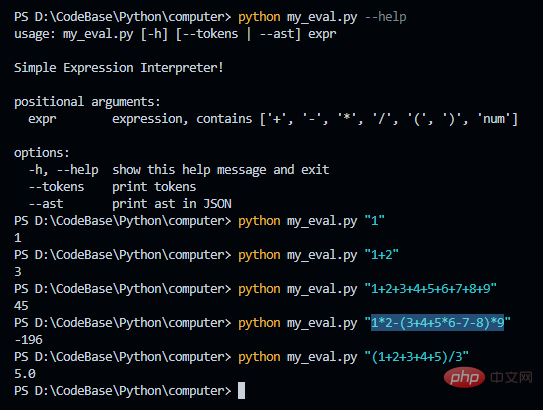
Output tokens
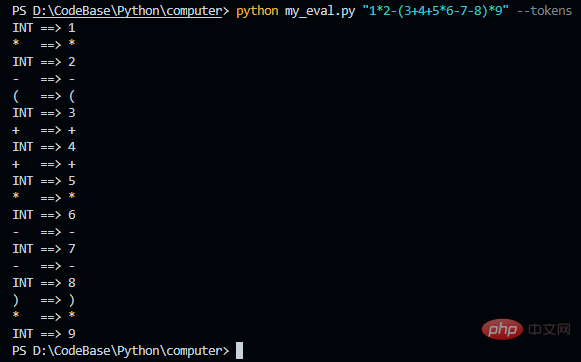
Output AST
This formatted JSON message is too long. Not conducive to direct viewing. We render it to see the final generated tree diagram (see the previous two blogs for methods). Save the following JSON in a file, here I call it demo.json, and then execute the following command: pytm-cli -d LR -i demo.json -o demo.html, and then open the generated file in the browser html file.
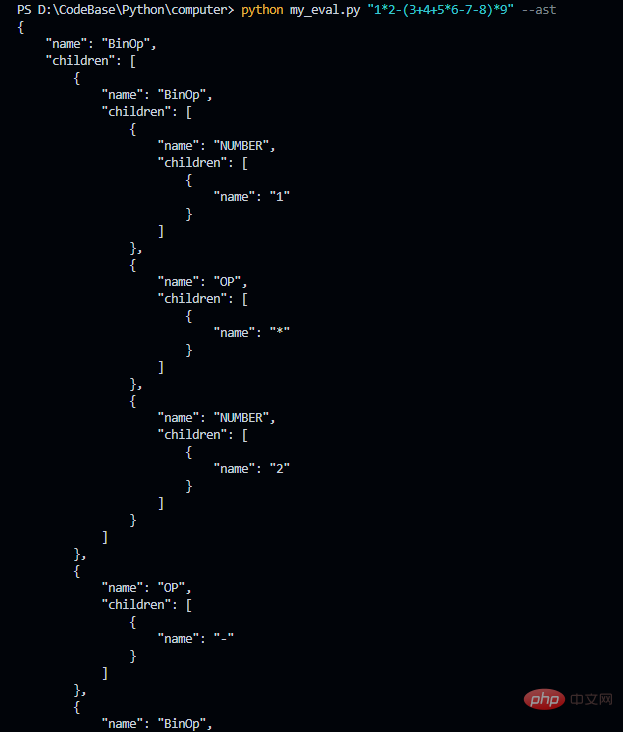
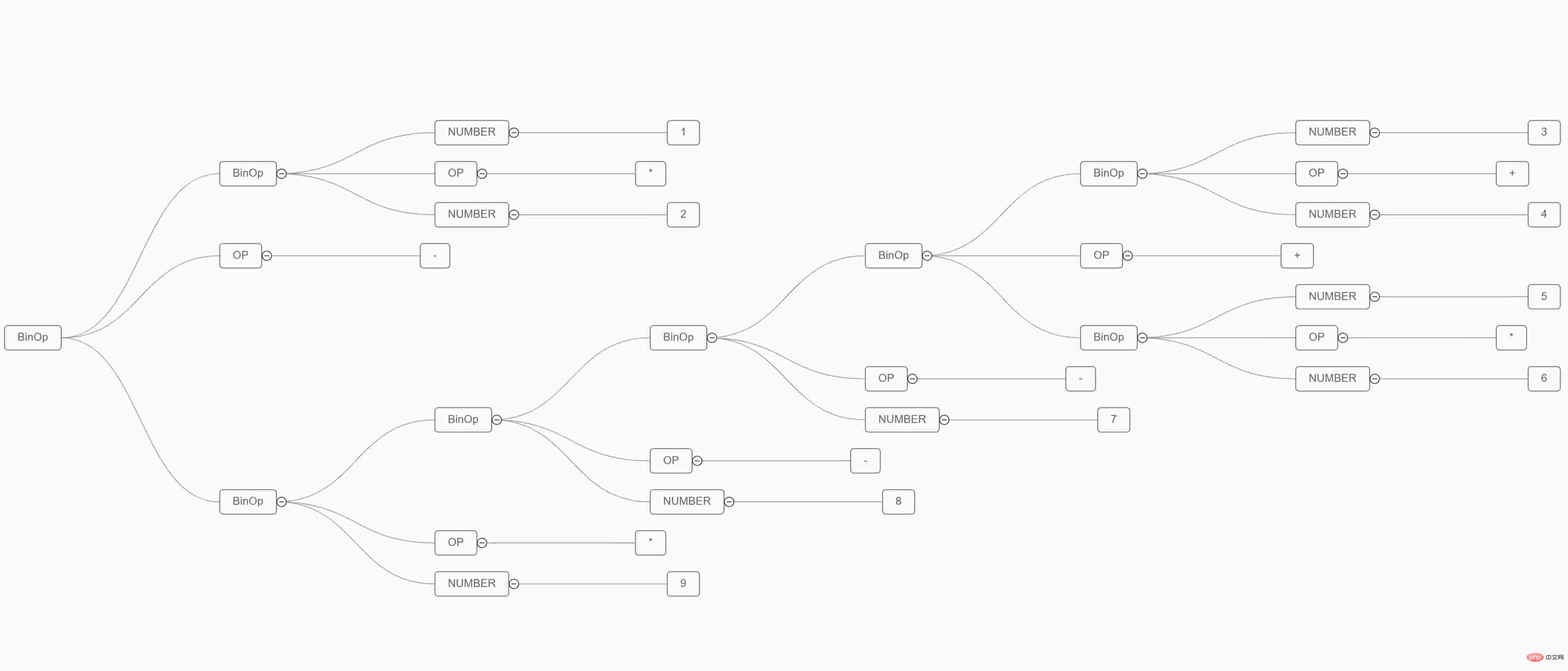
my_eval.py, if you want to run it, copy and paste, and then follow the steps of the demonstration.
The lexizer method in Calculator is used for word segmentation. Originally, I planned to use regularization. If you have read my previous blog, you can I found that I used regular expressions to segment words (because there is a simple word segmentation program in the regular expressions of Python's official documentation). But I saw that other people were writing participles by hand, so I did the same, but it didn’t feel very good, it was very tedious and error-prone.
The parse method is for parsing, mainly to analyze the structure of the expression, determine whether it conforms to the grammar of the four arithmetic operations, and finally generate the expression tree (its AST).
"""
Grammar
G -> E
E -> T E'
E' -> '+' T E' | '-' T E' | ɛ
T -> F T'
T' -> '*' F T' | '/' F T' | ɛ
F -> '(' E ')' | num | name
"""
import json
import argparse
class Node:
"""
简单的抽象语法树节点,定义一些需要使用到的具有层次结构的节点
"""
def eval(self) -> float: ... # 节点的计算方法
def visit(self): ... # 节点的访问方法
class BinOp(Node):
"""
BinOp Node
"""
def __init__(self, left, op, right) -> None:
self.left = left
self.op = op
self.right = right
def eval(self) -> float:
if self.op == "+":
return self.left.eval() + self.right.eval()
if self.op == "-":
return self.left.eval() - self.right.eval()
if self.op == "*":
return self.left.eval() * self.right.eval()
if self.op == "/":
return self.left.eval() / self.right.eval()
return 0
def visit(self):
"""
遍历树的各个节点,并生成 JSON 表示
"""
return {
"name": "BinOp",
"children": [
self.left.visit(),
{
"name": "OP",
"children": [
{
"name": self.op
}
]
},
self.right.visit()
]
}
class Constant(Node):
"""
Constant Node
"""
def __init__(self, value) -> None:
self.value = value
def eval(self) -> float:
return self.value
def visit(self):
return {
"name": "NUMBER",
"children": [
{
"name": str(self.value) # 转成字符是因为渲染成图像时,需要该字段为 str
}
]
}
class Calculator:
"""
Simple Expression Parser
"""
def __init__(self, expr) -> None:
self.expr = expr # 输入的表达式
self.parse_end = False # 解析是否结束,默认未结束
self.toks = [] # 解析的 tokens
self.index = 0 # 解析的下标
def lexizer(self):
"""
分词
"""
index = 0
while index < len(self.expr):
ch = self.expr[index]
if ch in [" ", "\r", "\n"]:
index += 1
continue
if '0' <= ch <= '9':
num_str = ch
index += 1
while index < len(self.expr):
n = self.expr[index]
if '0' <= n <= '9':
if ch == '0':
raise Exception("Invalid number!")
num_str = n
index += 1
continue
break
self.toks.append({
"kind": "INT",
"value": int(num_str)
})
elif ch in ['+', '-', '*', '/', '(', ')']:
self.toks.append({
"kind": ch,
"value": ch
})
index += 1
else:
raise Exception("Unkonwn character!")
def get_token(self):
"""
获取当前位置的 token
"""
if 0 <= self.index < len(self.toks):
tok = self.toks[self.index]
return tok
if self.index == len(self.toks): # token解析结束
return {
"kind": "EOF",
"value": "EOF"
}
raise Exception("Encounter Error, invalid index = ", self.index)
def move_token(self):
"""
下标向后移动一位
"""
self.index += 1
def parse(self) -> Node:
"""
G -> E
"""
# 分词
self.lexizer()
# 解析
expr_tree = self.parse_expr()
if self.parse_end:
return expr_tree
else:
raise Exception("Invalid expression!")
def parse_expr(self):
"""
E -> T E'
E' -> + T E' | - T E' | ɛ
"""
# E -> E E'
left = self.parse_term()
# E' -> + T E' | - T E' | ɛ
while True:
tok = self.get_token()
kind = tok["kind"]
value = tok["value"]
if tok["kind"] == "EOF":
# 解析结束的标志
self.parse_end = True
break
if kind in ["+", "-"]:
self.move_token()
left = BinOp(left, value, self.parse_term())
else:
break
return left
def parse_term(self):
"""
T -> F T'
T' -> * F T' | / F T' | ɛ
"""
# T -> F T'
left = self.parse_factor()
# T' -> * F T' | / F T' | ɛ
while True:
tok = self.get_token()
kind = tok["kind"]
value = tok["value"]
if kind in ["*", "/"]:
self.move_token()
right = self.parse_factor()
left = BinOp(left, value, right)
else:
break
return left
def parse_factor(self):
"""
F -> '(' E ')' | num | name
"""
tok = self.get_token()
kind = tok["kind"]
value = tok["value"]
if kind == '(':
self.move_token()
expr_node = self.parse_expr()
if self.get_token()["kind"] != ")":
raise Exception("Encounter Error, expected )!")
self.move_token()
return expr_node
if kind == "INT":
self.move_token()
return Constant(value=value)
raise Exception("Encounter Error, unknown factor: ", kind)
if __name__ == "__main__":
# 添加命令行参数解析器
cmd_parser = argparse.ArgumentParser(
description="Simple Expression Interpreter!")
group = cmd_parser.add_mutually_exclusive_group()
group.add_argument("--tokens", help="print tokens", action="store_true")
group.add_argument("--ast", help="print ast in JSON", action="store_true")
cmd_parser.add_argument(
"expr", help="expression, contains ['+', '-', '*', '/', '(', ')', 'num']")
args = cmd_parser.parse_args()
calculator = Calculator(expr=args.expr)
tree = calculator.parse()
if args.tokens: # 输出 tokens
for t in calculator.toks:
print(f"{t['kind']:3s} ==> {t['value']}")
elif args.ast: # 输出 JSON 表示的 AST
print(json.dumps(tree.visit(), indent=4))
else: # 计算结果
print(tree.eval())my_eval.py, but I feel that there are not many people behind it, so I will say it here. If you write a complex expression, how do you verify whether it is correct? Here we can just use Python, the most perfect interpreter, haha. Python's eval function is used here. Of course, you don't need to call this function, just copy the calculated expression directly. I use the eval function just to express why my program is called my_eval.
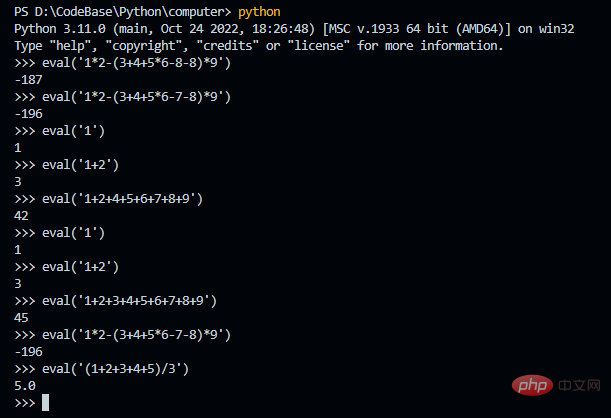
The above is the detailed content of Using Python to implement a simple four arithmetic interpreter. For more information, please follow other related articles on the PHP Chinese website!

Hot AI Tools

Undresser.AI Undress
AI-powered app for creating realistic nude photos

AI Clothes Remover
Online AI tool for removing clothes from photos.

Undress AI Tool
Undress images for free

Clothoff.io
AI clothes remover

AI Hentai Generator
Generate AI Hentai for free.

Hot Article

Hot Tools

Notepad++7.3.1
Easy-to-use and free code editor

SublimeText3 Chinese version
Chinese version, very easy to use

Zend Studio 13.0.1
Powerful PHP integrated development environment

Dreamweaver CS6
Visual web development tools

SublimeText3 Mac version
God-level code editing software (SublimeText3)

Hot Topics
 1385
1385
 52
52
 PHP and Python: Code Examples and Comparison
Apr 15, 2025 am 12:07 AM
PHP and Python: Code Examples and Comparison
Apr 15, 2025 am 12:07 AM
PHP and Python have their own advantages and disadvantages, and the choice depends on project needs and personal preferences. 1.PHP is suitable for rapid development and maintenance of large-scale web applications. 2. Python dominates the field of data science and machine learning.
 Python vs. JavaScript: Community, Libraries, and Resources
Apr 15, 2025 am 12:16 AM
Python vs. JavaScript: Community, Libraries, and Resources
Apr 15, 2025 am 12:16 AM
Python and JavaScript have their own advantages and disadvantages in terms of community, libraries and resources. 1) The Python community is friendly and suitable for beginners, but the front-end development resources are not as rich as JavaScript. 2) Python is powerful in data science and machine learning libraries, while JavaScript is better in front-end development libraries and frameworks. 3) Both have rich learning resources, but Python is suitable for starting with official documents, while JavaScript is better with MDNWebDocs. The choice should be based on project needs and personal interests.
 Detailed explanation of docker principle
Apr 14, 2025 pm 11:57 PM
Detailed explanation of docker principle
Apr 14, 2025 pm 11:57 PM
Docker uses Linux kernel features to provide an efficient and isolated application running environment. Its working principle is as follows: 1. The mirror is used as a read-only template, which contains everything you need to run the application; 2. The Union File System (UnionFS) stacks multiple file systems, only storing the differences, saving space and speeding up; 3. The daemon manages the mirrors and containers, and the client uses them for interaction; 4. Namespaces and cgroups implement container isolation and resource limitations; 5. Multiple network modes support container interconnection. Only by understanding these core concepts can you better utilize Docker.
 How to run programs in terminal vscode
Apr 15, 2025 pm 06:42 PM
How to run programs in terminal vscode
Apr 15, 2025 pm 06:42 PM
In VS Code, you can run the program in the terminal through the following steps: Prepare the code and open the integrated terminal to ensure that the code directory is consistent with the terminal working directory. Select the run command according to the programming language (such as Python's python your_file_name.py) to check whether it runs successfully and resolve errors. Use the debugger to improve debugging efficiency.
 Python: Automation, Scripting, and Task Management
Apr 16, 2025 am 12:14 AM
Python: Automation, Scripting, and Task Management
Apr 16, 2025 am 12:14 AM
Python excels in automation, scripting, and task management. 1) Automation: File backup is realized through standard libraries such as os and shutil. 2) Script writing: Use the psutil library to monitor system resources. 3) Task management: Use the schedule library to schedule tasks. Python's ease of use and rich library support makes it the preferred tool in these areas.
 Is the vscode extension malicious?
Apr 15, 2025 pm 07:57 PM
Is the vscode extension malicious?
Apr 15, 2025 pm 07:57 PM
VS Code extensions pose malicious risks, such as hiding malicious code, exploiting vulnerabilities, and masturbating as legitimate extensions. Methods to identify malicious extensions include: checking publishers, reading comments, checking code, and installing with caution. Security measures also include: security awareness, good habits, regular updates and antivirus software.
 How to install nginx in centos
Apr 14, 2025 pm 08:06 PM
How to install nginx in centos
Apr 14, 2025 pm 08:06 PM
CentOS Installing Nginx requires following the following steps: Installing dependencies such as development tools, pcre-devel, and openssl-devel. Download the Nginx source code package, unzip it and compile and install it, and specify the installation path as /usr/local/nginx. Create Nginx users and user groups and set permissions. Modify the configuration file nginx.conf, and configure the listening port and domain name/IP address. Start the Nginx service. Common errors need to be paid attention to, such as dependency issues, port conflicts, and configuration file errors. Performance optimization needs to be adjusted according to the specific situation, such as turning on cache and adjusting the number of worker processes.
 What is vscode What is vscode for?
Apr 15, 2025 pm 06:45 PM
What is vscode What is vscode for?
Apr 15, 2025 pm 06:45 PM
VS Code is the full name Visual Studio Code, which is a free and open source cross-platform code editor and development environment developed by Microsoft. It supports a wide range of programming languages and provides syntax highlighting, code automatic completion, code snippets and smart prompts to improve development efficiency. Through a rich extension ecosystem, users can add extensions to specific needs and languages, such as debuggers, code formatting tools, and Git integrations. VS Code also includes an intuitive debugger that helps quickly find and resolve bugs in your code.



